|
|
The Baron

|
|
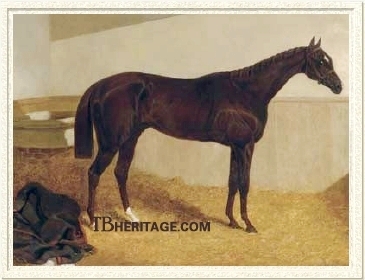 |
|
|
Even if The Baron had done nothing but get his famous son, STOCKWELL, his name would be preserved in perpetuity as part of the most successful sire line in thoroughbred history. He did more, however, by siring some excellent racehorses in France, notably his great daughter, LA TOUCQUES, and by leaving his famous broodmare daughter VERMEILLE, one of France's most significant matrons.
The Baron's story begins in Ireland, crosses to England, where he made his mark as a racehorse and stallion, and ends with all honors as a stud in France. His second dam, Miss Pratt (1825, by Blacklock), had been purchased in Yorkshire by Captain H.B. Gamble of Westmeath (Ireland) while he was on regimental duty in England. She was "low in stature, being under 15 hands in height, but very thick, with good bone and great length, in fact a picture to look at, being all quality, which she doubtless derived from Orville, the sire of her dam." She won some military races for the captain, whose best horse, Volcano, won the Madrid Handicap at the Curragh in 1849. When Gamble retired, he brought Miss Pratt back with him to his Irish stud, where she bred several "indifferent" foals.
Gamble died suddenly in 1837, and Miss Pratt was picked up for 120 guineas at the auction of his horses by George Watts, a Devon-born veterinarian who had moved to Ireland early in the century. Watts had established a good reputation with the leading trainers and breeders at the Curragh, and began to breed thoroughbreds, first in partnership with Robert Gore, and later on his own account, becoming one of the noted Irish breeders and trainers in the first half of the nineteenth century. Based at Jockey Hall at the Curragh, he was the leading owner of winners (money won) in Ireland five times -- in 1833, 1844, 1846, 1848 and 1855; his winners included King Dam, Marchioness d'Eu, and Chaseaway, all winners of the Royal Whip, and The Palmer and Mirza, both winners of the Madrid Handicap, and a number of other winning juveniles (including two half-siblings to The Baron).
Watts imported a number of stallions into Ireland, most notably Young Blacklock, whose sire, Blacklock had impressed him most of the stallions of the time, and he was intent on crossing with Waxy mares, which he did with great success, breeding the top Irish juveniles Whitefoot, Blackfoot and Magpie, among others. He put Miss Pratt, a Blacklock daughter, to the good stallion Economist (1825), a Waxy grandson of great power but "little quality" that was champion sire in 1842-3. Economist's winners including Irish champion racehorse and sire Harkaway. In 1838 Miss Pratt dropped the filly Echidna, a large, leggy foal with the Blacklock "fiddle head," an unpleasing shape ("frightful") to many horsemen, but to Watts proof that "like begets like."
Watts did not race Echidna, and at age three she was put to the stallion Birdcatcher (a Waxy great-grandson), who was located at the nearby Brownstown Stud. The next year, 1842, she dropped her first foal, a dark chestnut named The Baron. While his head was not as horrific as his dam's, The Baron, nonetheless, had a readily identifiable roman nose (downplayed in all the painted images of him), a trait seen in many of his immediate descendants (see the profile of his daughter, La Tocques, below). He inherited the quality of his sire, Birdcatcher, in body type, "oblique and beautiful" shoulders, and had good, clean legs, but he had bad feet, prone to abcesses, and his high spirits, controlled by the use of a muzzle, devolved into a reputation for savagery, partially mended when he was moved to the great trainer John Scott's stables midway through his three-year-old season.
Echidna went on to produce other winners, including Citron (1853, by Sweetmeat), a winner of the Anglesey and Railway Stakes at the Curragh for Watts, and The Baroness (1846, by Verulam) and Marchioness d'Eu (1847, by Magpie), both of which won the four mile Royal Whip at the Curragh.
The Baron on the Turf
Raced and trained by Watts, The Baron did not run as a juvenile, but at age three won three of his four starts in good company at the Curragh.
He started his career in the Madrid Stakes in April, where he was third to Highwayman (by Freney) and Hermit (by Birdcatcher), beating two others. At the same meeting, in the second class Madrid Stakes, he won, beating two other colts and conceding them eight pounds. In June at the Curragh he won the Kirwan Stakes, easily beating Wheel and The Cook, the only other horses in the race, both of which were tailed off, and at the same meeting took the Second Class of the Waterford Stakes, again easily besting by three lengths Ould Ireland, Will-o'the-Wisp, and Violet.
After this string of successive wins, Watts decided he had a horse that could win in England, and took The Baron to Liverpool to run in the Liverpool St. Leger Stakes on July 18, overweight and unfit, according to English horsemen ("fat as a bull"), and with bar shoes to protect his "fearfully festered soles." He did not place in the race, won by Newcastle Northern Derby winner Mentor, with Pantasa second and Vaudeville third. Watching in the stands was the great Malton, Yorkshire, trainer John Scott who told Watts (according to Lord George Bentinck): "If you will send that horse to Whitewall without delay, he shall win the Doncaster Leger for you." Watts put The Baron in Scott's able hands, with less than nine weeks until the running of the Doncaster St. Leger. "A very rough and snappish customer they thought him at first," said The Druid, and Scott later said he "took more work than I ever gave a horse in my life, and required more management." But, trying him at Pigburn over the St. Leger distance against the three-year-old filly As-you-like-it (by Touchstone), and giving her a stone, Scott decided The Baron's one length lead at the finish of the trial was a good indicator of his probable success at Doncaster.
The Baron won the St. Leger at Doncaster (1 mile-6 furlongs) by a length, beating the fine Gladiator filly, Miss Sarah (winner of the Gerat Yorkshire Stakes and Doncaster's Park Hill Stakes that year), with Pantasa third, and Weatherbit, Annandale, and ten others in the field. He got up to pass Miss Sarah in the last few strides of the race, and her trainer asked the stewards to hold the award until The Baron's mouth was examined to confirm his age -- after all, he had beat an outstanding filly and no one in England knew anything about him -- which it was the following day. In October Scott took The Baron to Newmarket, where he beat, again by a length, a huge field of 26 horses in the premier fall handicap, the Cesarewitch (2 miles-2 furlongs). After this race, Watts could not turn down the huge £4,000 offer by E.R. Clark for his purchase, and The Baron passed into Clark's hands to run in the second half of the fall double, the Cambridgeshire (1 mile-1 furlong), where he failed to place in the event, won by the great speedster Alarm, with Event second and Yardley third.
After he passed out of Scott's hands, The Baron never won another race. In the 1846 season, age four, his glories were behind him. Clark sold him to sportsman John Mytton (who spent a lot of his fortune "unwisely" --e.g. gambling -- and ended up broke, dying debtor's prison). At Chester The Baron did not place in the Chester Cup, won by Corranna, and then at Epsom he ran second to Spithead in the Craven Stakes, beaten by a short head, with four others in the field. He failed to place in Alarm's Emperor of Russia's Plate (Ascot Gold Cup), and was not in the money, or even quoted for odds in the Liverpool Cup in July, won by Lightning.
The Baron in the Stud
While he was slated by Mytton to run in 1847, The Baron was instead sold to John Theobald, owner of the Stockwell Stud in Surrey, on the outskirts of London. Theobald had been a prominent racehorse breeder for many years and had had a number of good stallions at the farm, including Camel, Tarrare, Laurel, and Muley Moloch. The Baron was only at Stockwell for three seasons, and not being in the best odure after his poor showing at age four, got few mares. One of these was Ally Crocker, by Albemarle, who, in 1849, dropped CHIEF BARON NICHOLSON, an attractive black colt that later won the Stockbridge Triennial and was third in the Derby. Another was Theobald's mare, Pocahontas (by Glencoe), who had produced nothing of particular note until she hit with The Baron. Her first foal by him, born in 1849, was the famous STOCKWELL, through which most thoroughbreds today descend in tail-male. The next year she dropped RATAPLAN (1850), but by then The Baron was in France. Theobald died, age 83, in October of 1849, and his stud was put under the hammer. The Baron was picked up for £1,010 by Perrot de Thannberg, who was on a stallion-buying mission for the French government, and was dispatched in 1850 to the national stud, Bois du Haras, where he stood at a fee of 300 francs.
|
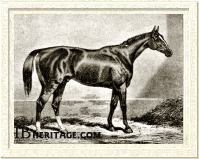
Stockwell
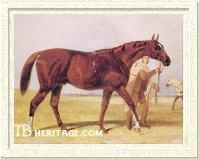
Rataplan
|
|
STOCKWELL (1849) was the first of his dam's good runners and influential breeding stock, and the among the first, and by far the most significant, of The Baron's offspring. A big golden chestnut with his sire's roman nose, he won the Two Thousand Guineas Stakes, the Doncaster St. Leger, and other good races -- including eight in succession -- and retired at the end of 1854. In the stud he was a phenomenon in his own time, leading the sire's list in England seven times, with 12 winners of 17 classic races, and with over half his 400-plus offspring winners of at least one race. He got a number of sires sons, but his male line persisted primarily through Derby winner Doncaster, the latter sire of Derby winner Bend Or, and through him the tail-male line persists and dominates to the present. Other Stockwell sons with extended sire lines included St. Leger winner St. Albans and Lord Lyon.
STOCKWELL'S year-younger full brother, RATAPLAN (1850), a 16 hand tall dark chestnut, was, despite a vertical tendency in his shoulder and pasterns, a superior stayer and winner of 42 of his 82 starts, including the Doncaster Cup, the Cambridgeshire Stakes, and the Ascot Gold Vase. He retired sound from his hard years of campaigning at the end of his five-year-old season, and was purchased at Tattersall's for £2,000 by Mr. Foljambe and Lord Scarborough. He stood his entire life at Tickhill Stud, and while not a patch on his brother as a sire, he was in the list of the top ten sires in England five times.
|
RATAPLAN got Derby winner Kettledrum, the incredibly strong weight-carrying Rapparee (Ascot Stakes, etc.), The Drummer, Knutsford, Irish Derby winner Ben Battle (later a good sire of jumpers) and many other winners. His daughters were successful broodmares, including Mineral, the dam of Epsom Derby winner Kisbér and St. Leger winner Wenlock; Hasty Girl, dam of Kilwarlin and Bendigo; Rigolboche, who produced Epsom Derby winner Cremorne; and Mandragora, the dam of the excellent staying mare Agility and her sisters, the dual-classic winner Apology and Analogy, the dam of Elf, the latter winner of the big distance races in France and the Ascot Gold Cup, and later a leading sire in France.
After the successes of STOCKWELL and RATAPLAN, an effort was made to repurchase The Baron to England; The Druid said a 3,000 guineas offer was made, but by then The Baron was regularly turning out winners in France, and he remained there until his death. He got off to a rocky start in France, due in part to his uncertain temper. The Druid reported in 1856 that a visitor to the Bois du Hars said The Baron "was as rough and uncared for as a bear, and that seeing how dirty and below par the whole establishment was, it was no wonder the young stock turned out ill."
But his offspring that began running at about this time -- the mid-1850s -- proved to be very high-class racers, with some of his best, such as ZOUAVE and LES TOUCQUES still to be born. He got three classic winning fillies and two classic winning colts, numerous top distance horses and some good juveniles, and several of his broodmare daughters had a significant influence of French bloodstock breeding. He did not get a sire son in France that did well beyond a generation or two. If statistics had been compiled for the time, he would certainly have been the leading sire in France in 1863, with LES TOUCQUES' multiple classic wins, and the several wins of PERGOLA, which included the rich Prix Daru.
One of The Baron's first good runners was DAME D'HONNEUR (1853), from the Ibrahim mare Annetta, that had been a very good winner of numerous races, including the Poule d'Essai, and the Prix du Printemps and Prix de l'Administration des Haras at Versailles. Annetta was one of the first high-class mares to be sent to The Baron. DAME D'HONNEUR, owned by Count Frederic de Lagrange, was third in the Poule d'Essai, and then beat the very good race filly, Miss Cath, in the Prix de Diane, afterwards running second to Miss Cath in the Grand Saint Leger and the Omnium. In the stud she produced Duc de Beaufort (1869 by Ventre St. Gris), a winner of The Grand Sefton Steeplechsae at Aintree. Her half-sister, Annette (1848, by Gladiator), produced BARONELLO (1861) to the cover of The Baron: he won the Poule d'Essai des Poulains (French Two Thousand Guineas) in 1864 for Nathan de Rothschild.
Another early French winner of The Baron's was ISOLIER (1853, from the imported Defence mare, Deception). He won the Prix de L'Empereur (later the Prix Lupin) over 2100 meters for his owner, Auguste Lupin. REMUNERATEUR (1851, from Margarita by Royal Oak) won the 2200 meter Prix du Cadran at Champ-de-Mars. |
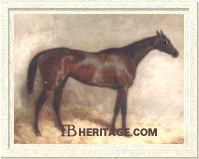
Etoile du Nord
|
|
The bulk of The Baron's good runners in France were born in 1855 and later. ETOILE DU NORD (1855), was from imported Maid of Hart --by The Provost -- also dam of the half-siblings Compeigne, winner of the Prix du Cadran, and Monseigneur, winner of the Manchester Cup, Prix de la Foret, and Grosser Preis von Baden. ETOILE DU NORD won the Prix de Diane for de LaGrange, beating the excellent Ion daughter, Goëlette. Etoile du Nord was later dam of two winners that took both the Prix du Cadran (4200 meters) and the Grand Prix Imperatrice (Prix Rainbow, 5000 meters), both by Monarque -- Auguste (1863, also winner of the 6200 meter Prix Gladiateur) and Longchamp (1864), and a daughter, Honora, by Consul, bred on, with stakes winning descendants into the twentieth century.
|
Another good 1855 daughter of The Baron was LA MALADETTA (1855, from the imported Epsom Oaks winner Refraction by Glaucus). Racing for her breeder, Auguste Lupin, the stout LA MALADETTA was considered one of the best of her year: she won the two big races at Baden-Baden, the Prix de la France, and the Grosser Preis von Baden (beating Gouvieux, Ventre St. Gris, and other good ones), and placed third in the Grand St. Leger in France. She was later a superior broodmare, producing Tourmalet (1862, winner of the Poule de Produits (Prix Daru), Prix de la Foret, and other races, second in Grand Prix de Paris), Cerdagne (1866, Prix Lupin, Furstenberg-Rennen and Grosser Preis von Baden winner), Nethou (1869, winner of more than six races, including the Poule de Produits (Prix Daru), and third in the Prix du Jockey Club), and Vignemale (1876, winner of the Prix Biennial (Prix Jean Prat) and good broodmare), dying soon after the birth of the latter. Her tail-female family is still active.
TONNERE DES INDES (1855, out of Serenade by Royal Oak) won the top juvenile race in France, the Grand Criterium at Longchamp, but he was unable to train on successfully. He was a minor stallion in France, getting, among others, Graziella, a winner of the Prix Principal at Caen (5,000 meters) and other races. FORT-A-BRAS (1855), from Suprema, by Physician, won some races at age three, and was second in the Grand St. Leger, and the following year won the rich Prix de la Ville de Paris, beating ZOUAVE by a head. He was not a successful stallion.
ZOUAVE (1855, from the Gladiator Cambridgeshire-winning daughter Dacia) was probably The Baron's best running son in France, but he had a "very high character and violent fanciful moods," attributed to his sire, that affected his racing consistency. He was bred by Auguste Aumont and purchased and raced by Frederic de LaGrange. At age three his wins included the Prix de la Societe d'Encouragement at Versailles and the Ominium at Paris. The next year he won the rich Prix des Pavillons at Paris, the Prix de Haras at Chantilly, the Prix Imperial and one other race at Paris, and was second to FORT-A-BRAS in the Prix de la Ville at Paris. At age five he won at Amiens, and in England, placed third in both the Stewards Cup and the Goodwood Cup at Goodwood. In the stud of Baron Nexon, he got some good -- but frequently erratic -- horses that mostly ran in the south of France, often over jumps, including Enfant de Troupe (1870, Prix d'Halatte and other races), the jumper Balancelle (1863), Tiralleur (1868, winner of the Grand Prix de Bourges and other races), Avant Garde (1869, winner of the Principal and the National at Tarbes, second in the Prix de la Ville de Paris), Cantiniere, and Glaîeul.
ZOUAVE'S full sister, NOELIE (1859) was another good filly by The Baron. She was second to Stradella in the Prix de Diane, and that same year dead-heated with Stradella in the Grand Prix de la Societé at Versailles, but lost the run-off. At age five she won the 6200 meter Grand Prix de l'Empereur (Prix Gladiateur). NOELIE was the dam of winners, including Don Carlos (1867, by Monarque, winner of ten races, including the Prix Gladiateur, at age four, in France and England; Eole II (1868, by West Australian), who took the Prix Morny, and other races in France, and in England won Ascot's All Aged Stakes and several Queen's Plates. NOELIE'S daughter, Navarre (1870, by Ventre St. Gris) was third dam of Prix du Jockey Club winner and sire Negofol (1906).
ISABELLA (1859), from the Gladiator daughter Regrettee, won Longchamp's Grand Criterium as a juvenile, and in England took a small handicap at Newmarket, and the next year she took the Poule d'Essai des Pouliches (French One Thousand Guineas) at Longchamp for Le Grande Ecurie. Her line bred on for a few generations.
COSTA (1859), out of the Epsom Oaks winner Catherine Hayes, by Lanercost, won Newmarket's Mottisfort and Chesterfield Stakes in 1861, and at age three took the Dee Stakes, Berkshire Stakes and Free Handicap at Newmarket. His dam, sent to France for the one-time breeding to The Baron, was brought back to England, where she produced another good juvenile, Belladrum, by Stockwell, and a daughter by Wild Dayrell, Cantata, that bred two classic winners in Germany.
|
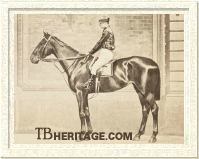
La Toucques
|
|
The Roman-nosed LA TOUCQUES (1860), out of Tapestry, by Melbourne, was trained at Middleham in Yorkshire, by John Fobert for her owner Alexander Montgomery. She ran once as a juvenile at York, unsuccessfully, and then was taken to France. Her second effort was the Prix de Diane, which she easily won. Next up was the Prix du Jockey Club, where she beat a good field by 2-1/2 lengths, that included Dollar, Hospodar and Saccharometer. She entered the lists for the Grand Prix de Paris the favorite at 2:1 odds -- it was *the* event of the racing season that included four English horses -- Lord Clifden, Saccharometer, The Orphan and The Ranger -- and attracted all manner of the elite, including the Emperor and Empress, the Prince of Orange, the King of Portugal, the entire diplomatic corps, ministers, and various court hangers-on. The Ranger won this race by a length, with the grand LA TOUCQUES second, to the consternation of all, but The Ranger's owner, Henry Savile, cushioned the blow, somewhat, by donating 10,000 francs to the Parisian poor.
|
LA TOUCQUES then went to Baden-Baden and won the Grosser Preis von Baden (3200 meters), again beating Dollar into second place. She followed this by winning the Prix de l'Empereur at Chantilly and finished the season by winning the Grand Prix du Prince Imperial (Prix Royal Oak) at Longchamp (3200 meters). She ran for two more years, but did nothing of note. Her tail-female line is still active, and includes the two-time Prix d'Ispahan winner Crystal Glitters (1980) and the stakes winner Danzatore (1980).
Another daughter of The Baron born in 1860 was LA REINE BERTHE, out of Creeping Jenny by Inheritor, and so a half-sister to Prix du Jockey Club winner Black Prince and the grand race mare Stradella (Prix de Diane, Poule d'Essai, etc.). She was purchased back for 6,000 francs by Frederic de LaGrange when he disbanded his partnership in the Le Grande Ecurie. At age five she won the 3,000 meter Prix Kergolay at Deauville. Her tail-female descendants included classic winners in France, among them the siblings Ramleh (Prix Royal Oak) and Riposte (Poule d'Essai des Pouliches). Another daughter of The Baron, NOBILITY (1860, out of Effie Deans) also won the Prix Kergolay (in 1864); her tail-female descendants included two Italian classic-winning brothers, Onorio (1902) and Plinio (1903).
PERGOLA (1860, out of Officious by Pantaloon) was a good three-year old runner, winning the Biennal, the Poule des Produits over 2,000 meters at Longchamp (Prix Daru), the Prix de la Ville, and a rich handicap at Valenciennes. In the stud she bred Perla (1871, by Dollar), a winner of the Grand Prix de Deauville at age four.
In addition to The Baron's daughters previously mentioned as broodmares, he got VERMEILLE (1853, from Fair Helen by Priam). She was bred by J. Verry and purchased by Count F. de Montguyon. She wasn't much as a racehorse, winning three small provincial races at age three -- the Grand Prix de la Ville and the Prix du Conseil General at Chalons-sur-Marne, and the Grand Prix de la Ville at Boulogne. She was sold to Comte Murat as a saddle horse, and then was purchased by Henri Delamarre as a broodmare for his Haras Bois-Roussel. There she became one of France's most famous broodmares, that even had a race named after her in France. She bred Grand Prix de Paris winner and top sire Vermout, who got the champion Boiard and the leading sire Perplexe. Her next foal, Vertugadin, won the Grosser Preis von Baden and was later a successful sire. After that came Verite, winner of the Fürstenberg-Rennen; Verdure, dam of a Prix de Diane winner; Verone, who produce a winner of the Grand Criterium; Verte-Allure, dam of another Prix de Diane winner and other good runners, and finally Extra, dam of a Prix du Cadran winner. Within 50 years of VERMEILLE'S birth, her tail female descendants included seven Grand Prix de Paris winners, six Prix du Jockey Club winners, and eight Prix de Diane winners.
Another filly usually attributed to The Baron, but properly by The Baron or Nuncio, was COMTESSE (1855, from Eusebia by Emilius). This filly, raced by Frederic de LaGrange, won the Derby Continental at Gand, and later produced Ascot Gold Cup winner Mortemer, a useful sire, and his half-sister, Nemea, winner of the Prix Biennal (Prix Jean Prat), the Prix de la Foret, and the Newmarket October Handicap. There seems to have been a bit of confusion at the Bois du Haras, with mares often put successively to different stallions in the same season. The Baron is also listed as the possible sire of POTACKI (1854, usually attributed to Nunnykirk), winner of the Prix du Jockey Club in 1857, and the Prix du Cadran in 1858; of BAKALOUM (1856, almost certainly by Ion), winner of the 1859 Poule d'Essai; of PEU D'ESPOIR (1852, probably by The Emperor), winner of a famous match against Prix de Diane winner Ronzi; of BARONCINO (1852, probably by The Emperor), winner of Prix de l'Empereur (Prix Lupin); and finally of the great stallion MONARQUE (1852, generally agreed to be by The Emperor).
Beyond France, The Baron's influence was primarily confined to sons of STOCKWELL and RATAPLAN. Their contributions in England have been documented. In addition, no less than six Stockwell sons went to Australia, as did two Rataplan sons as well as several Rataplan grandsons. Of Stockwell's sons sent to Australia, the most successful were the dual-classic winner The Marquis (1859), and the 1873 Two Thousand Guineas winner Gang Forward (1870, from Lady Mary by Orlando). The Marquis got many good juveniles and Newminster (1873, from Spa by Leamington), a winner of the Caulfield Cup and later himself a top sire (twice leading the sire's list in Australia), particularly of classic winners and superior cup horses. Gang Forward also got good juveniles and two S.A.J.C. St. Leger winners. Rataplan's son, The Drummer (1866, from My Niece by Cowl) got many good runners that won at 12 furlongs and further, including the gelded Masquerade (1874), and was a successful broodmare sire. In New Zealand, it was the Doncaster son, St. Leger, that dominated the sire's list in the 1890s.
The Baron is known today as the sire of STOCKWELL, whose exported, British-born, grandsons and great-grand sons spread this sire line throughout the world -- Italy, France, Germany, and the U.S. But he was also extremely influential through RATAPLAN'S good broodmare daughters, and through his own daughters -- particularly VERMEILLE, whose descendants had such an influence on French racing.
--Patricia Erigero |
|
|
|

